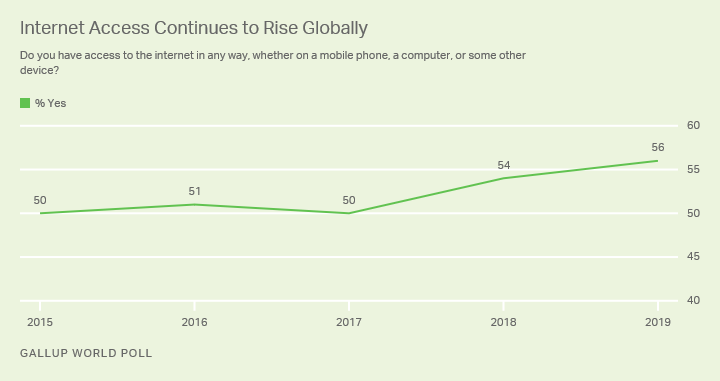Story Highlights
- Nearly six in 10 adults worldwide (56%) report access to the internet
- Access rates are highest in North America, Australia/New Zealand, and Europe, lowest in South Asia and sub-Saharan Africa
- Nearly four in five (79%) workers employed full time for an employer report access
WASHINGTON, D.C. -- With more than 1 million confirmed cases of COVID-19 worldwide and counting, many residents confined to their homes for the foreseeable future are relying on the internet as their link to the outside world. Gallup surveys in 145 countries and territories in 2019 and early 2020 show more of the world is online than ever, but there is still a digital divide.
A Majority of the World Has Access to the Internet
Since its inception, the internet has exploded in popularity, rapidly becoming a tool for work, education and leisure. As recently as 2015, half of the world's adults reported having access to the internet in some way, including those connecting through a mobile device. This number has risen in recent years, with 56% of adults globally reporting the ability to get online in 2019, an increase of six percentage points over the past two years.

Digital Divide Narrower, but Remains
More adults worldwide can get online, but access to the internet still largely depends on where they live. Northern America, Australia and New Zealand, and Europe stand out with nearly ubiquitous access among residents. At the same time, little more than one in five living in South Asia (21%) can get online.
However, despite low rates of connectivity in some regions, many are seeing substantial growth in the number of people gaining access to the internet in recent years. The percentage of people connected in Southeast Asia, for example, has risen 13 percentage points over the past two years, growing from 42% in 2017 to 55% today.
| 2017 | 2018 | 2019 | |||||||||||||||||||||||||||||||||||||||||||||||||||||||||||||||||||||||||||||||||||||||||||||||||
|---|---|---|---|---|---|---|---|---|---|---|---|---|---|---|---|---|---|---|---|---|---|---|---|---|---|---|---|---|---|---|---|---|---|---|---|---|---|---|---|---|---|---|---|---|---|---|---|---|---|---|---|---|---|---|---|---|---|---|---|---|---|---|---|---|---|---|---|---|---|---|---|---|---|---|---|---|---|---|---|---|---|---|---|---|---|---|---|---|---|---|---|---|---|---|---|---|---|---|---|
| % | % | % | |||||||||||||||||||||||||||||||||||||||||||||||||||||||||||||||||||||||||||||||||||||||||||||||||
| Northern America | 89 | 91 | 94 | ||||||||||||||||||||||||||||||||||||||||||||||||||||||||||||||||||||||||||||||||||||||||||||||||
| Australia-New Zealand | 92 | 91 | 93 | ||||||||||||||||||||||||||||||||||||||||||||||||||||||||||||||||||||||||||||||||||||||||||||||||
| European Union | 84 | 87 | 87 | ||||||||||||||||||||||||||||||||||||||||||||||||||||||||||||||||||||||||||||||||||||||||||||||||
| Europe (Other) | 78 | 83 | 82 | ||||||||||||||||||||||||||||||||||||||||||||||||||||||||||||||||||||||||||||||||||||||||||||||||
| East Asia | 66 | 67 | 71 | ||||||||||||||||||||||||||||||||||||||||||||||||||||||||||||||||||||||||||||||||||||||||||||||||
| Commonwealth of Independent States (CIS) | 66 | 68 | 70 | ||||||||||||||||||||||||||||||||||||||||||||||||||||||||||||||||||||||||||||||||||||||||||||||||
| Latin America and the Caribbean | 58 | 60 | 68 | ||||||||||||||||||||||||||||||||||||||||||||||||||||||||||||||||||||||||||||||||||||||||||||||||
| Middle East and North Africa | 59 | 62 | 63 | ||||||||||||||||||||||||||||||||||||||||||||||||||||||||||||||||||||||||||||||||||||||||||||||||
| Southeast Asia | 42 | 46 | 55 | ||||||||||||||||||||||||||||||||||||||||||||||||||||||||||||||||||||||||||||||||||||||||||||||||
| Sub-Saharan Africa | 25 | 30 | 31 | ||||||||||||||||||||||||||||||||||||||||||||||||||||||||||||||||||||||||||||||||||||||||||||||||
| South Asia | 15 | 25 | 21 | ||||||||||||||||||||||||||||||||||||||||||||||||||||||||||||||||||||||||||||||||||||||||||||||||
| Do you have access to the Internet in any way, whether on a mobile phone, a computer, or some other device? | |||||||||||||||||||||||||||||||||||||||||||||||||||||||||||||||||||||||||||||||||||||||||||||||||||
| Gallup World Poll | |||||||||||||||||||||||||||||||||||||||||||||||||||||||||||||||||||||||||||||||||||||||||||||||||||
For many, particularly those in developing regions, the spread of "smart" mobile devices has brought access to the internet to many. A 2019 report from the trade association GSMA found that mobile devices are the primary means of getting online for residents living in low- and middle-income countries, while the International Telecommunication Union (ITU) finds that 93% of the world's population is within range of a 3G or higher network signal.
However, while this growth promotes increased connectivity for much of the world, its impact on the ability to work from home remains uneven. As many jobs may require the use of a computer, internet connectivity solely through a mobile device may not allow employees to work remotely. The ITU finds that there are twice as many households with a computer per 100 inhabitants in developed countries, compared to those in developing nations.
COVID-19 Adds New Impetus to Work From Home
As offices, stores and factories worldwide shutter their physical locations to enforce social distancing, many office workers who can work from home are doing so. However, the ability to work from home largely depends on the type of work, as well as the capacity to get online at workable internet speeds.
In the United States, where 94% of adults reported having internet access last year, 62% of employed Americans say they worked from home due to the coronavirus as of April 2, according to Gallup Panel data.
This ability is also largely tied to the field of work for many. For many white-collar professions, 2018 figures from the Bureau of Labor Statistics indicate that 29% of Americans are able to work from home, including more than half of information technology employees. A recent study by Pew found that 40% of working-age adults in the U.S. have worked from home because of the COVID-19 outbreak.
Many countries outside of the U.S. are seeing a surge in employees working from home as companies worldwide close their doors. Vodafone, one of the largest telecommunications providers in Europe, has seen internet use rise 50% in several countries as more workers get online from home.
Even regions without a prominent work-from-home culture are being forced to experiment with the new arrangement. China, for example, has seen millions of employees working from home in recent months, particularly in cities most affected by the coronavirus spread.
Most Adults Working Full Time for an Employer Are Connected
For many home workers, access to the internet plays a crucial role in staying connected. Fortunately, many full-time workers worldwide have a way to get online in some capacity. Among those who report being employed full time for an employer (25% of all adults worldwide in 2019), nearly four in five (79%) can connect to the internet. However, for self-employed workers, slightly less than half (48%) report having this ability.
Those employed full time for an employer are most likely to be found in Northern America, Europe and East Asia (including Australia and New Zealand), while adults living in sub-Saharan Africa are the least likely to report working for an employer full time.
| Yes, has access to the Internet | No, does not have access | ||||||||||||||||||||||||||||||||||||||||||||||||||||||||||||||||||||||||||||||||||||||||||||||||||
|---|---|---|---|---|---|---|---|---|---|---|---|---|---|---|---|---|---|---|---|---|---|---|---|---|---|---|---|---|---|---|---|---|---|---|---|---|---|---|---|---|---|---|---|---|---|---|---|---|---|---|---|---|---|---|---|---|---|---|---|---|---|---|---|---|---|---|---|---|---|---|---|---|---|---|---|---|---|---|---|---|---|---|---|---|---|---|---|---|---|---|---|---|---|---|---|---|---|---|---|
| % | % | ||||||||||||||||||||||||||||||||||||||||||||||||||||||||||||||||||||||||||||||||||||||||||||||||||
| Employed full time for an employer | 79 | 20 | |||||||||||||||||||||||||||||||||||||||||||||||||||||||||||||||||||||||||||||||||||||||||||||||||
| Employed full time for self | 48 | 52 | |||||||||||||||||||||||||||||||||||||||||||||||||||||||||||||||||||||||||||||||||||||||||||||||||
| Employed part time, do not want full time | 52 | 47 | |||||||||||||||||||||||||||||||||||||||||||||||||||||||||||||||||||||||||||||||||||||||||||||||||
| Unemployed | 52 | 47 | |||||||||||||||||||||||||||||||||||||||||||||||||||||||||||||||||||||||||||||||||||||||||||||||||
| Employed part time, want full time | 50 | 49 | |||||||||||||||||||||||||||||||||||||||||||||||||||||||||||||||||||||||||||||||||||||||||||||||||
| Out of workforce | 46 | 53 | |||||||||||||||||||||||||||||||||||||||||||||||||||||||||||||||||||||||||||||||||||||||||||||||||
| Do you have access to the Internet in any way, whether on a mobile phone, a computer, or some other device? | |||||||||||||||||||||||||||||||||||||||||||||||||||||||||||||||||||||||||||||||||||||||||||||||||||
| Gallup World Poll, 2019-2020 | |||||||||||||||||||||||||||||||||||||||||||||||||||||||||||||||||||||||||||||||||||||||||||||||||||
Online Access Provides New Paths for Education and Healthcare
Apart from its workplace applications, growing connectivity has provided pathways for many to access personal services, including healthcare, digitally. In China, where 70% of adults reported having access to the internet last year, Ali Health set up an online clinic for residents in locked-down Hubei, which reported seeing 100,000 patients in five days through remote consultations. As global residents continue to shelter in their homes, virtual medicine visits have the potential to provide aid to those unable or unwilling to obtain healthcare in person.
Education is another online area of growing importance, particularly in households with children that have been forced to remain at home as schools close down worldwide. A recent study of U.S. parents found that 70% reported their child is using an online distance learning program from their school.
However, the ability to have children take classes online is only a viable option for those with access to the internet. Globally, a slim majority (51%) of adults with children younger than age 15 in the household report having access to the internet, compared with 62% who have no young children at home.
| Yes, has access to the Internet | No, does not have access to the Internet | ||||||||||||||||||||||||||||||||||||||||||||||||||||||||||||||||||||||||||||||||||||||||||||||||||
|---|---|---|---|---|---|---|---|---|---|---|---|---|---|---|---|---|---|---|---|---|---|---|---|---|---|---|---|---|---|---|---|---|---|---|---|---|---|---|---|---|---|---|---|---|---|---|---|---|---|---|---|---|---|---|---|---|---|---|---|---|---|---|---|---|---|---|---|---|---|---|---|---|---|---|---|---|---|---|---|---|---|---|---|---|---|---|---|---|---|---|---|---|---|---|---|---|---|---|---|
| % | % | ||||||||||||||||||||||||||||||||||||||||||||||||||||||||||||||||||||||||||||||||||||||||||||||||||
| No children in household | 62 | 38 | |||||||||||||||||||||||||||||||||||||||||||||||||||||||||||||||||||||||||||||||||||||||||||||||||
| Children in household | 51 | 49 | |||||||||||||||||||||||||||||||||||||||||||||||||||||||||||||||||||||||||||||||||||||||||||||||||
| Gallup World Poll, 2019-2020 | |||||||||||||||||||||||||||||||||||||||||||||||||||||||||||||||||||||||||||||||||||||||||||||||||||
Implications
Rising access to the internet enables many workers to stay connected and perform essential work functions remotely. Given the relatively smooth transition noted by some workers, some experts see working from home as a new normal that may continue to be adopted even after offices reopen. However, the growth of many digital features, including telemedicine, remote working and online education options, will remain constrained by the availability of reliable internet access in many countries.
For complete methodology and specific survey dates, please review Gallup's Country Data Set details.
Learn more about how the Gallup World Poll works.




